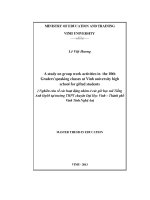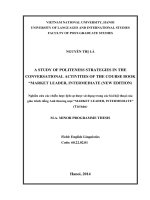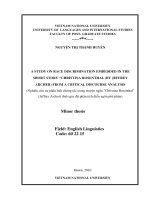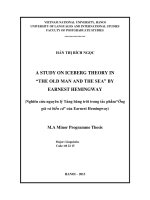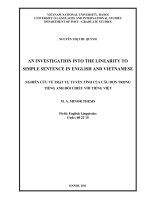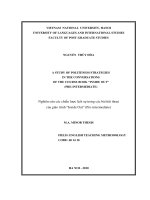A study on teacher’s politeness in the EFL classroom – nghiên cứu về chiến thuật lịch sự của giáo viên trong lớp học tiếng anh như một ngoại ngữ
Bạn đang xem bản rút gọn của tài liệu. Xem và tải ngay bản đầy đủ của tài liệu tại đây (1.44 MB, 130 trang )
VIETNAM NATIONAL UNIVERSITY, HANOI
UNIVERSITY OF LANGUAGES AND INTERNATIONAL STUDIES
FACULTY OF POST-GRADUATE STUDIES
TRAN HOANG ANH
A STUDY ON TEACHER’S POLITENESS STRATEGIES
IN THE EFL CLASSROOM
(Nghiên cứu chiến lược lịch sự của giáo viên
trong lớp học tiếng Anh)
MA MAJOR THESIS
Major: English Linguistics
Code: 8220201.01
Hanoi, 2019
VIETNAM NATIONAL UNIVERSITY, HANOI
UNIVERSITY OF LANGUAGES AND INTERNATIONAL STUDIES
FACULTY OF POST-GRADUATE STUDIES
TRAN HOANG ANH
A STUDY ON TEACHER’S POLITENESS STRATEGIES
IN THE EFL CLASSROOM
(Nghiên cứu chiến lược lịch sự của giáo viên
trong lớp học tiếng Anh)
MA MAJOR THESIS
Major: English Linguistics
Code: 8220201.01
Supervisor: Prof. Dr. Nguyen Hoa
Hanoi, 2019
DECLARATION
I hereby state that this thesis is my own work and that, to the best of my
knowledge and belief, it contains no material that has been accepted or
submitted for the award of any other degree or diploma.
I also declare that, to the best of my knowledge and belief, this thesis
contains no material previously published or written by any other person except
where due reference is made in the text of the thesis.
i
ACKNOWLEDGEMENTS
I would first like to express my deepest gratitude to my thesis supervisor,
Prof. Nguyen Hoa, for his precious support and helpful instructions on the
construction of my study, which have always been the decisive factors in the
completion of this paper. The door to Prof. Nguyen Hoa’s office was always
open whenever I ran into a trouble spot or had a question about my research or
writing. He consistently allowed this paper to be my own work, but steered me
in the right the direction whenever he thought I needed it.
My sincere gratitude is also addressed to Dr. Huynh Anh Tuan, Dean of
Faculty of Post-graduate studies, and Dr. Hoang Thi Hanh, lecturer in Faculty
of Linguistics and Cultures of English speaking countries, ULIS, VNU, for
their sharing expertise, and critical comments for my thesis proposal.
Thirdly, I would like to send our heartfelt thanks to the teacher and the
students at FELTE, ULIS for their participation in the study. Without their
cooperation and input, the study could not have been successfully conducted.
Furthermore, I would also like to express my appreciation to my friend,
Huy Hoang, for his spending time helping me proofread my thesis.
Finally, I must express my very profound gratitude to my family and my
friends for providing me with unfailing support and continuous encouragement
throughout my years of study and through the process of researching and
writing this thesis. This accomplishment would not have been possible without
them.
ii
ABSTRACT
This interpretive-qualitative research aimed at investigating a teacher’s
politeness strategies used in the classroom, how they were recognized
linguistically through her utterances, and her students’ perception of such
language. The data were collected through non-participatory observations and
semi-structured interviews. The data analysis was based on Brown and
Levinson’s politeness theory (1987). The results revealed that the teacher
employed certain types of politeness in her teaching English, namely, bald-on
record strategy, positive politeness and negative politeness. As such, the
teacher created a positive teacher-student interaction and supportive learning
atmosphere. Furthermore, the findings showed that most students found their
teacher’s utterances appropriate and effective for their learning process.
Nevertheless, it came to the researcher’s realization that Brown and Levinson’s
politeness theory could not capture all aspects of Vietnamese people’s
politeness. Cross-cultural communication was taken into consideration during
the data analysis, accordingly, for better interpretation of the occurrence
emerging in the classroom.
iii
TABLE OF CONTENT
DECLARATION .............................................................................................. i
ACKNOWLEDGEMENTS............................................................................ ii
ABSTRACT .................................................................................................... iii
LIST OF ABBREVIATIONS ....................................................................... vi
LIST OF TABLES AND FIGURES ............................................................ vii
CHAPTER 1. INTRODUCTION .................................................................. 1
1.1. Background to the study.......................................................................... 1
1.2. Rationale to the study .............................................................................. 2
1.3. Significance of the study .......................................................................... 4
1.4. Scope of the study ..................................................................................... 5
1.5. Organization of the thesis ....................................................................... 5
CHAPTER 2. LITERATURE REVIEW ...................................................... 7
2.1. Overview of Politeness ............................................................................. 7
2.2. Root of Linguistic Politeness ................................................................... 8
2.3. Robin Lakoff and Politeness ................................................................. 12
2.4. Brown and Levinson’s politeness strategies ........................................ 13
2.4.1. Bald-on-Record ..................................................................................... 15
2.4.2. Positive Politeness Strategy .................................................................. 16
2.4.3. Negative Politeness Strategy ................................................................. 18
2.4.4. Off-Record Strategy .............................................................................. 20
2.4. Critique of Brown and Levinson’s politeness strategies .................... 24
2.5. Teacher’s language in EFL classroom ................................................. 26
2.6. Concept of perception ............................................................................ 27
2.7. Related studies on Teacher’s politeness strategies in EFL classroom .... 29
iv
CHAPTER 3. METHODOLGY .................................................................. 33
3.1. Research design ...................................................................................... 33
3.2. Participants ............................................................................................. 34
3.3. Data collection instruments ................................................................... 34
3.3.1. Addressing research question 1 ............................................................ 34
3.3.2. Addressing research question 2............................................................. 37
3.4. Data analysis ........................................................................................... 38
3.4.1. Data Reduction ...................................................................................... 41
3.4.2. Data display ........................................................................................... 41
3.4.4. Conclusion drawing and verification .................................................... 42
CHAPTER 4. FINDINGS AND DISCUSSION ......................................... 42
4.1. Findings ................................................................................................... 44
4.1.1. Teacher’s politeness strategy in EFL classroom ................................... 44
4.1.2. Students’ perception on teacher’s utterances in the EFL classroom .... 61
4.1.3. Other findings........................................................................................ 63
4.2. Discussion ................................................................................................ 67
CHAPTER 5. CONCLUSION ..................................................................... 73
5.1. Summary of the findings ....................................................................... 73
5.2. Implications of the findings ................................................................... 75
5.3. Limitations of the study ......................................................................... 77
5.4. Suggestions for further study ................................................................ 77
REFERENCES .............................................................................................. 78
APPENDICES .................................................................................................. I
APPENDIX 1 .................................................................................................... I
APPENDIX 2 .............................................................................................XXII
v
LIST OF ABBREVIATIONS
CEFR
Common European Framework of Reference
D
Social distance
EFL
English as Foreign Language
FTAs
Face-threatening acts
H
Hearer
IELTS
International English Language Testing System
L2
Second language
P
Relative power
Rx
absolute rating of imposition
S
Speaker
vi
LIST OF TABLES AND FIGURES
Figure 2.1. Strategies for performing FTAs (Brown & Levinson, 1987) ....... 15
Table 2.1. Summary of Brown and Levinson’ politeness strategies (1987)
......................................................................... Error! Bookmark not defined.
Table 3.1. Observation timeline ...................................................................... 35
Table 3.2. Coding scheme for the types of politeness strategies .................... 36
Table 3.3. Coding scheme for the types of sub-politeness strategies ............. 36
Table 3.4. Unit of data analysis ....................................................................... 41
Figure 4.1. Number of teacher’s politeness strategies used in the classroom ....... 44
vii
CHAPTER 1. INTRODUCTION
This chapter introduces the research area and outlines the background
and the rationale for the current study. It briefly review teacher’s language in
EFL classroom and politeness strategy applied in such context. The chapter
subsequently describes the aims, scopes and significance of the present study,
followed by the organization of the research.
1.1. Background to the study
During the last six years teaching English for freshmen and sophomores,
my colleagues and I have witnessed a rather disturbing phenomenon in which
intermediate and upper-intermediate L2 students were often reluctant to raise
their voice in English in the classroom. In retrospect, I found myself in the same
situation as my students. Were it not for the teacher’s encouragement or
acknowledgement of my ideas, I would not have had the willingness to raise
my voice in class. “Teacher’s encouragements would probably be the solution
for my students”, I thought. I then took into consideration this experience when
planning the lessons. I spent much time thinking about the language I would
use in class, so that through my saying, I could encourage and motivate my
students to speak more. Still, I felt quite puzzled. Much as I planned the
language used beforehand, I failed to stir up the class atmosphere sometimes.
Why the students show little interest in learning English in class? Is there
anything a teacher can do, besides giving encouragements, to stimulate the
student’s interest?
It comes to my realization that in a specific language learning
environment, classroom activities hosted (not controlled, but guided) by
teacher helps shape a special interpersonal relationship. This is similar to any
1
other social relationship. To promote the effective communication as well as to
develop good relationship or togetherness, being polite could be seen as the one
of the core elements in social interactions. The teachers, hence, probably should
take into consideration “how to speak” and “what to speak” so that they could
sound more polite in the classroom. For instance, utterances such as please,
would you and thank you are regarded as polite in teacher-students interaction.
Being aware of how politeness strategies are employed in the teacher’s
utterances, accordingly, is also of significance.
1.2. Rationale to the study
Teacher’s language in EFL classroom has widely been considered the
most important factor affecting the teaching-learning process. It is because the
teacher’s language is not only for classroom management but also for the
process of students’ knowledge acquisition (Nunan, 1991). There are several
activities universally conducted by the teacher in the classroom, such as giving
the student’s instructions, motivating the class, and evaluating the students.
More importantly, teacher’s language in the classroom is also the major
medium for L2 learners to understand the knowledge. That is to say, in EFL
classroom, English is not only the target for students to learn but also the
medium for the teaching-learning process. English used in L2 classroom is not
only the goal of the lesson but also how this goal is achieved, in other words
(Richards & Lockhart, 1996). ELF teachers, thus, play the role as the models
for their students to imitate. Krashen (1995) asserts that if the teacher’s
language is used properly in EFL classroom, it would pave the way for the best
input for the learner’s language learning process. The appropriateness of the
teacher’s language in classroom context could be defined as “how the teacher
speaks” to make students feel comfortable, i.e. they do not feel offended by the
teacher’s utterances. As such, the teacher’s way of speaking should not cause a
2
threat to the student’s face. According to Brown and Levinson (1987) to
mitigate face-threat, further, create good teacher-students interaction, the
teacher is supposed to be polite in the classroom. Politeness is a common social
phenomenon and a classroom is one society in which communication occurs
between teachers and students. Thus, politeness should also be a moral code in
the teaching-learning process. In respect to language, politeness corresponds to
the use of indirect speech acts or using certain lexical items such as “please”,
“sorry”, and “thank you” (Watts, 2003). That is to say, teachers’ politeness in
the EFL classroom can be recognized linguistically through the structural form
and communication function of the utterances, especially in the event of
teacher-student interaction.
A previous study by Jiang (2010) on Teacher’s politeness in EFL class
(a case study of Chinese EFL learners) concluded that politeness does exist in
EFL classroom. Furthermore, it was alos concluded that teacher’s politeness
strategies did contribute to both teaching and learning. Jiang, through his
analysis, claimed that politeness in the classroom contributed to the effective
relationship, created a friendly and lively atmosphere and will affect the mutual
understanding and the relationship between student and teacher. A similar
conclusion was reached by the study conducted by Peng, Cai, and Xie (2014)
on college teacher’s politeness strategies in EFL classroom. The authors
asserted that teachers in EFL classroom are highly aware of politeness
strategies and often used negative politeness and positive politeness as their
strategies in the classroom. Teachers preferred to use positive politeness as it
helped the students to develop their self-image.
In Vietnam, there has been little research investigating on teacher’s
utterances in EFL classroom, let alone teacher’s politeness strategies in asking
for student’s clarification. That is to say, teacher’s use of politeness strategies
as well as its influence on the teaching-learning process has not been dealt with
3
in-depth in Vietnam, especially in the university context. Furthermore, to my
observation, freshmen and sophomores in my faculty tend to show more
interest and enthusiasm in learning English with young teachers. Such a
phenomenon has posed a question of how young teachers employ politeness
strategies, thus, they could establish a close relationship with students in the
EFL class.
1.3. Aims of the study
With a view to addressing the aforementioned gaps, this study aims at
investigating how politeness strategies employed by one Vietnamese teacher
can be a variable that enhances teacher-student interaction, further, improves
L2 students’ learning in EFL classroom.
Considering the objectives of the research, the research would seek the
answer for these three following research questions:
Question 1: What politeness strategies are used by the teacher in the EFL
classroom?
Question 2: What are the students’ perceptions of the effectiveness and
appropriateness of their teacher’s utterances in EFL classroom?
1.4. Significance of the study
When the thesis is completed, it would be beneficial to teachers and L2
leaners. It also documents several key contributions made to the research body
of politeness strategy used in EFL classroom. To be more specific, the results
of this research should be seen as a useful tool for L2 teachers to reflect their
use of politeness strategies in the classroom. As a result, EFL teachers would
be more aware of their use of politeness strategies in their classroom and there
would be some modification in teachers’ language used in the classroom. As a
consequence, the teacher could improve teacher-student interaction in EFL
classroom, and the teaching-learning process would be more efficient.
4
Secondly, the researcher hopes this study would be a useful source of reference
for other studies in linguistics and pragmatic fields, further, it would enrich the
literature regarding politeness strategies used in EFL classroom.
1.5. Scope of the study
This study focuses on teacher’s politeness strategies in the EFL
classroom, in which both the teacher and the students are Vietnamese with
Vietnamese culture. That is to say, both the teacher and the students are nonnative speakers and they use English as a medium for the teaching-learning
process as well as for their interaction in the classroom context. It should be
noted that Vietnamese used in the classroom is also studied as the
translanguaging resources. Besides, politeness can also be expressed nonverbally, however, only the linguistic politeness will be analyzed and discussed
in this current study. Moreover, L2 students’ perceptions of their teacher’s
utterances during the teaching-learning process would also be the subject for
discussion.
1.6. Organization of the thesis
Chapter 1 – Introduction – presents a general statement about the study and the
objectives that the study would want to achieve.
Chapter 2 – Literature Review – gives the background of the study, consisting
of definitions and descriptions of key concepts and related studies, both inside
and outside of Vietnam.
Chapter 3 – Methodology – gives descriptions of the participants and the
settings for the study as well as the procedure employed to carry out the
research.
5
Chapter 4 – Results – presents the findings together with in-depth analysis and
discussion of the findings – gives answers to the two research questions
proposed in the introduction chapter.
Chapter 5 – Conclusion – summarizes the main issues discussed in the study,
the limitations of the research and proposes some recommendations and
suggestions for further studies.
References and Appendices come at the end of the study.
6
CHAPTER 2. LITERATURE REVIEW
This chapter will present the theoretical issues relevant to the study
including the theory of linguistic politeness in general and Brown and
Levinson’s theory of politeness strategy in particular. This will be followed by
the framework for the study. A critical appraisal of the previous studies related
to the current research area will also be presented at the end of the chapter.
2.1. Overview of Politeness
The English lexeme 'polite' lies in the Latin past participle form politus,
meaning 'polished'. The same is true for the French term poli, which is the past
participle of the verb polir, meaning to polish. Thus, it is understood that “The
etymological roots of the terms 'polite' and 'politeness' in English are (thus) to
be found in notions of cleanliness, a smooth surface and polished brightness
which can reflect the image of the beholder” (Watts, 2003, p33).
The concept Politeness has been studied since the 1960s from the
perspectives of many scientific fields – psychology, philosophy, sociology,
ethnomethodology, social anthropology and linguistics. This thesis will be
focused on the most prominent one, i.e. the linguistic point of view. Since
politeness can be understood as an instrument, it is logical that the research of
politeness is usually classified as a part of linguistic pragmatics, a discipline
that studies language from the functional point of view and assesses the
appropriateness of use of certain elements of speech in particular
communication.
The pragmatic turn in linguistics dates back to the second half of the
1960s. Yule (1996, p4) follows Morris in describing pragmatics as “the study
of the relationships between linguistic forms and the users of those forms.”
7
While syntax is the study of how linguistic forms are arranged in a
sequence, and semantics examines the relationship between linguistic forms
and entities of the world, pragmatics is concerned with the notion of
implicature, i.e. implied meaning as opposed to the mere lexical meaning
expressed. Pragmatics is the study of speaker meaning, or contextual meaning,
and dwells upon how more than what is said is expressed and the expression of
relative distance in a natural language setting (Yule, 1996, p.3). A large body
of linguistic research has moved from language disciplines, focusing on
competence, to parole disciplines, emphasizing language performance. The
parole perspective brings context into linguistics, i.e. the relationship between
speaker and addressee, illocutionary effect, topic and motivation of
communication, and due to this every text or discourse is considered a unique
event of perception and creation.
2.2. Root of Linguistic Politeness
We should first mention the theories of the “fathers of pragmatics” in
brief to see the framework of politeness concepts that will be analyzed later on
in the text. First and foremost, it is John Austin, the author of theory of speech
acts and whose lecture series named How to Do Things with Words (1962)
reveals that we not only say things, but we also do things when using language
(John, 1962). A speech act is, therefore, an utterance, functioning as a unit of
communication. Theoretically, there are three components in a speech act: the
Locutionary Act (producing the actual meaningful utterance), the Illocutionary
Act (the intended significance and socially valid verbal actions, such as
ordering, warning, undertaking etc.) and the Perlocutionary Act (the actual
effect of the utterance, or what we achieve with an utterance, such as
convincing, persuading, deterring, surprising, misleading). The Illocutionary
Act determines a certain illocutionary force. When the illocutionary force is
8
different from the Locutionary Act, this situation is called an indirect speech
act. A typical example of an indirect speech act is a request formulated as a
question: Could you open the window?
Building upon Austin’s work, Searle (1965) argues that “A theory of
language is a part of theory of action”. This could be understood as, since
language is intentional behavior, it should be treated like a form of action.
Moreover, to understand language one must understand the speaker’s intention
as when one speaks, one performs an act. Searle further proposes that all acts
fall into five main types: representatives, directives, commissives, expressives,
and declarations.
The aim of the speaker, therefore, is to make the addressee understand
his/her intention. In other words, to convey the illocutionary force, the speaker
can use intonation, punctuation, and verb performatives (verbs, such as
promise, invite, apologize, and forbid, that explicitly convey the kind of speech
act being performed), or the illocutionary force can be assigned to the
interpretation itself. Sometimes the type of the Illocutionary Act comes from
the context of a communication, for example I am here by car as a reply to I
missed my bus is an offer. Due to these hints, the act is called Illocutionary,
because the word illocutionary derives from the word illoquor, meaning
unexpressed. (Grepl & Karlík, 1998, p. 419).
Furthermore, Searle (1969) specifies the conditions that each
Illocutionary Act must fulfill. He divides these conditions into three types:
preparatory conditions (e.g. a preparatory condition for reprehension is the fact
that the addressee has done something wrong), sincerity conditions (the
subjective standpoint of a speaker, e.g. a sincerity condition of a question is the
speaker’s desire to learn something new), and essential conditions (the aim of
the speaker, e.g. the essential condition of an announcement is to inform the
addressee about the content).
9
The basis of the majority of linguistic theories on politeness could be
traced back to the Cooperative Principle of H.P. Grice. His theory can be
succinctly illustrated by the following sentence, taken from his essay Logic and
Conversation: Make your conversational contribution such as is required, at
the stage at which it occurs, by the accepted purpose or direction of the talk
exchange in which you are engaged. (Grice, 1975, p45). Grice further suggests
four conversational maxims under the Cooperative Principle which are
prerequisites for a successful and effective communication (Grice, 1989, p2829):
The Cooperative Principle (abbreviated to CP)
QUANTITY: Give the right amount of information: i.e.
1. Make your contribution as informative as required.
2. Do not make your contribution more informative than is required.
QUALITY: Try to make your contribution the one that is true: i.e.
1. Do not say what you believe to be false.
2. Do not say that for which you lack adequate evidence.
RELATION: Be relevant.
MANNER: Be perspicuous; i.e.
1. Avoid obscurity of expression.
2. Avoid ambiguity.
3. Be brief (avoid unnecessary prolixity).
4. Be orderly. (Grice, 1989, p28-29)
The floating of these maxims can lead to un-cohesive communication or
misunderstanding. Even though the CP is always valid, participants of a
conversation often break its principles, for which they usually have a reason.
When a speaker breaks one of the maxims, the addressee starts thinking of the
reasons the speaker might have had. S/he starts adding the missing pieces of a
conversation that were not explicitly mentioned, but are still somehow present
in the utterance, and the speaker wishes the addressee to understand them.
10
These implicit parts of utterances are called conversational implicatures. “The
presence of a conversational implicature must be capable of being worked out”
(Grice 1970, p50). One of the reasons for breaking a maxim can also be
politeness. An example of this is when a wife tells her husband, “The Novák
family are coming over for dinner tonight” and the husband replies, “It will be
nice to see Jana”. The husband’s reply floats the maxim of quantity, but is more
polite than explicitly saying that he does not like Mr. Novák. Moreover, Grice
himself maintains that some maxims are more important than others, and he
also acknowledges that these maxims are often violated. Nevertheless, they
seem to form the basis of any rational conversation. Grice also points out that
his list of maxims is not final, and identifies other important maxims, e.g. “Be
polite”:
There are, of course, all sorts of other maxims (aesthetic, social, or moral in
character) such as ‘Be polite’ that are normally observed by participants in
talk exchanges and these may also generate nonconventional (i.e.
conversational) implicatures. (Grice 1991,p.308)
These words have inspired many linguists who have elaborated on Grice’s
suggestion for a certain politeness maxim. Names connected with linguistic
politeness are Robin Lakoff, Geoffrey Leech and Brown and Levinson and
Watts. There are other linguists who deal with politeness (e.g. Fraser and Nolen,
Eelen, Scollon and Scollon), but the theories of Lakoff, Leech, Brown and
Levinson and Watts are generally considered the most influential ones.
Accordingly, this thesis will predominantly draw on on the latter.
The term ‘linguistic politeness’ refers to strategies that aim at conflictfree communication, especially Leech’s Politeness Principle, and also at the
self-realization and the self-defense of a speaker in a conversation. The theories
of the above-mentioned linguists have shaped the perception of linguistic
politeness, and they will provide a framework for the research in the practical
part of this thesis.
11
2.3. Robin Lakoff and Politeness
The idea that politeness can be studied and interpreted as adhering to
certain pragmatic rules was first worded by Robin Lakoff in her essay The
Logic of Politeness: or, Minding your p’s and q’s (1973, p.45). Here, Lakoff
defines politeness as forms of behavior that have been “developed in societies
in order to reduce friction in personal interaction.” According to her,
pragmatic competence consists of a set of sub-maxims, namely:
1- Be clear and 2- Be polite.
The continuity of Grice’s thought is clear, especially in the fact that Grice’s
Cooperative Principle in a way overlaps with Lakoff’s first rule. Again, there
are many situations in which the requirement of the first maxim (be clear) is
more important than the other one (be polite), and vice versa. Lakoff (1973,
p297-298) clarifies this relationship by asserting that,
Politeness usually supersedes. It is considered more important in a
conversation to avoid offense than to achieve clarity. This makes sense, since
in most informal conversations, actual communication of important ideas is
secondary to merely reaffirming and strengthening a relationship.
Lakoff (1973) characterizes politeness from the perspective of the speaker,
identifying three sub-types
1. formal (or impersonal) politeness (Don't impose/remain aloof).
2. informal politeness – hesitancy (Give options)
3. intimate politeness – equality and camaraderie (make A feel good – be
friendly/act as though you and the addressee were equal)
These strategies (distance, deference and camaraderie) are usually
applied in different circumstances. When the relationship between the speaker
and addressee is not close, formal politeness should prevail, and the speaker
must conform to social etiquette. The speaker should be indirect, and in certain
situations can be considered reserved.
12
According to Lakoff (1973), informal politeness is typical of women. A
speaker using strategies of informal politeness can sound indecisive, because
s/he leaves the decision to the addressee.
In brief, Lakoff views politeness both as a way to avoid giving offense
and as a lubricator in communication that should maintain harmonious relations
between the speaker and the hearer. This view, accordingly, would function as
the basis for the researcher to analyze as well as compare different politeness
models so that the most suitable one would be chosen.
2.4. Brown and Levinson’s politeness strategies
One of the most influential, detailed and well-known models of linguistic
politeness is that of Penelope Brown and Stephen C. Levinson in 1987. It is
said that “perhaps the most thorough treatment of the concept of politeness is
that of Brown and Levinson” (Fasold, 2000, p.160). Their book, Politeness:
Some Universals in Language Usage, was first published in 1978; however, we
usually cite the second edition from 1987, where the authors answer various
objections to their theory. Brown and Levinson were not only inspired by
Grice’s CP and Austin’s and Searle’s theory of speech acts, but also by Erving
Goffman’s conception of face (1967).
Goffman understands the construct of face in accordance with certain
English folk terms, like losing face or saving face, and defines face as “an
image of self - delineated in terms of approved social attributes- albeit an
image that others may share” (Goffman, 1967, p.5).
Face is the public self-image of a person. Thus, every participant of a
conversation has a face, and everyone’s task in a conversation is to maintain
and protect his or her face within the interlocutors. However, face can be
threatened in specific situations and such threats are called face-threatening acts
(FTAs).
13
The concept of face was borrowed from Goffman by Brown and
Levinson (1987), and used in their Model Person, who can be defined by the
following three characteristics: this person speaks a natural language, is rational
(and therefore capable of means-end reasoning) and has a face. Consequently,
this Model Person is used by Brown and Levinson to illustrate the connection
between the use of language and politeness.
In their theory, face is two dimensional – they work with the concepts of
positive and negative face. However, the terms positive and negative are not
subject to evaluation; we cannot consider the positive face to be better than the
negative one. The terms are meant in a directional way (vectorial), i.e. the
positive face metaphorically aims outwards and the negative inwards, into the
inner world of the speaker. On the one hand, Brown and Levinson (1987, p.61)
define the positive face as “the positive consistent self-image of ‘personality’
(crucially including the desire that this self-image be appreciated and
approved of) claimed by interactants.” On the other hand, the negative face is
defined as our wish not to be imposed on by others and to be allowed to go
about our business unimpeded with our rights to free and self-determined action
intact. To sum up, the negative face is the desire of every ‘competent adult
member’ for his/her actions to be unimpeded by others. The positive face is the
wish of every member for his/her wants to be desirable to at least some others.
It should be the interest of all participants in a conversation to enable each other
to save their face, minimizing face-threatening acts. As Watts describes it
(2003, p.86)
politeness strategies will therefore be those which aim (a) at supporting or enhancing
the addressee’s positive face (positive politeness) and (b) at avoiding transgression
of the addressee’s freedom of action and freedom from imposition (negative face).
Positive politeness serves to make the hearer feel liked and approved of;
whereas negative politeness serves to minimize the imposition on the hearer.
14
Figure 2.1. Strategies for performing FTAs (Brown & Levinson, 1987)
Followings are more explanation of each politeness strategy according
to Brown and Levinson’s theory.
2.4.1. Bald-on-Record
In the Bald-on record strategy, the speaker does nothing to minimize
threats to the hearer’s face. The reason for its usage is that whenever a speaker
wants to do the FTA with maximum efficiency more than he or she wants to
satisfy the hearer’s face, even to any degree, the Bald-on record strategy chosen
according to Brown and Levinson (1987, 1895).
There are two kinds of bald-on record as follows
A. Non-minimization of the face threat
Non-minimization of the face threat is the standard uses of Bald-on
record usage where other demands override face concerns. S and H both agree
that the relevance of face demands may be suspended in the interest of urgency
or efficiency. This strategy is most utilized in situations where the speaker has
a close relationship with the audience.
B. FTA- oriented bald-on record usage
The theory of Brown and Levinson (1987) explains the use of Bald-on
record is actually face-oriented. In other words, it is used where face involves
15
mutual orientation, so that each participant attempts to foresee what the other
participant is attempting to foresee. For example, in certain circumstances, it is
reasonable for S to assume that H will be especially worried with H’s potential
violation or S’s maintaining.
2.4.2. Positive Politeness Strategy
Brown and Levinson (1987, p.70) define positive politeness as the
strategy oriented by the speaker towards the positive face or the positive selfimage of the hearer. The speaker can satisfy the addressee’s positive face wants
by emphasizing that speaker wants what the hearer’s wants. Positive politeness
techniques are usable not only for FTA redress, but as kind of social accelerator
that indicates the speaker’s wants to come closer to hearer.
Positive politeness strategy is classified into 15 sub-strategies as follows
(Brown & Levinson, 1987, p103-129)
1)
Strategy 1: Notice, attend to Hearer (his interest, wants, needs, goods)
The strategy suggests that S (speaker) should take notice as aspects of
hearer’s condition of the listener (the changes can also note, common
ownership, and everything that listeners want to be noticed and recognized by
the speakers).
2)
Strategy 2: Exaggerate (interest, approval, sympathy with H)
This strategy is often done with exaggerated intonation, stress, and other
aspects of prosodic, as well as intensifying modifiers.
3)
Strategy 3: intensify interest to H
Another way for S to share his wants with the H is to intensify the interest
of S’s own contributions to the conversation, by “making good story”.
4)
Strategy 4: use in-group identity markers (addressed forms, dialect,
jargon or slang)
This strategy is done by using innumerable address forms to indicate that
S and H belong to some set of persons who share specific wants. In conveying
16

